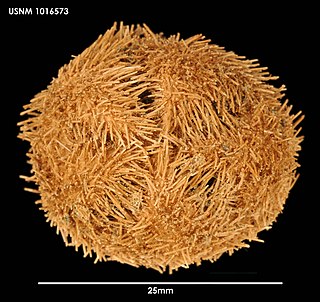Amphipneustes bifidus is a species of sea urchin of the family Temnopleuridae. Their armor is covered with spines. It is placed in the genus Amphipneustes and lives in the sea. Amphipneustes bifidus was first scientifically described in 1950 by Ole Mortensen, a Danish scientist.

Amphipneustes koehleri is a species of sea urchin of the family Temnopleuridae. Their armour is covered with spines. It is placed in the genus Amphipneustes and lives in the sea. Amphipneustes koehleri was first scientifically described in 1905 by Ole Mortensen.

Amphipneustes similis is a species of sea urchin of the family Temnopleuridae. Their armour is covered with spines. It is placed in the genus Amphipneustes and lives in the sea. Amphipneustes similis was first scientifically described in 1936 by Ole Mortensen, Danish zoologist.
Anabrissus damesi is a species of sea urchin of the family Brissidae. Their armour is covered with spines. It is placed in the genus Anabrissus and lives in the sea. Anabrissus damesi was first scientifically described in 1881 by Alexander Agassiz, American scientist and engineer.
Anochanus sinensis is a species of sea urchin of the family Cassiduloida. Their armour is covered with spines. It is placed in the genus Anochanus and lives in the sea. Anochanus sinensis was first scientifically described in 1868 by Adolph Grube.
Antrechinus drygalskii is a species of sea urchin of the family Urechinidae. Their armour is covered with spines. It is placed in the genus Antrechinus and lives in the sea. Antrechinus drygalskii was first scientifically described in 1905 by Ole Mortensen, Danish zoologist.
Araeosoma alternatum is a species of sea urchin of the family Echinothuriidae. Its armour is covered with spines. It is placed in the genus Araeosoma and lives in the sea. A. alternatum was first scientifically described in 1934 by Ole Theodor Jensen Mortensen, a Danish zoologist.
Araeosoma belli is a species of sea urchin of the family Echinothuriidae. Its armour is covered with spines. It is placed in the genus Araeosoma and lives throughout the Caribbean Sea as well as areas around the Gulf of Mexico. A. belli was first scientifically described in 1903 by Ole Theodor Jensen Mortensen, a Danish zoologist.

Araeosoma owstoni is a species of sea urchin of the family Echinothuriidae. Its armour is covered with spines. It is placed in the genus Araeosoma and lives in the sea. A. owstoni was first scientifically described in 1904 by Ole Theodor Jensen Mortensen.

Araeosoma parviungulatum is a species of sea urchin of the family Echinothuriidae. Its armour is covered with spines. It is placed in the genus Araeosoma and lives in the sea. A. parviungulatum was first scientifically described in 1934 by Ole Theodor Jensen Mortensen.
Araeosoma splendens is a species of sea urchin of the family Echinothuriidae. Its armour is covered with spines. It is placed in the genus Araeosoma and lives in the sea. A. splendens was first scientifically described in 1934 by Ole Theodor Jensen Mortensen.
Araeosoma violaceum is a species of sea urchin of the family Echinothuriidae. Its armour is covered with spines. It is placed in the genus Araeosoma and lives in the sea. A. violaceum was first scientifically described in 1903 by Ole Theodor Jensen Mortensen.

Arbaciella elegans is a species of sea urchin of the family Arbaciidae. Their armour is covered with spines. It is placed in the genus Arbacia and lives in the sea. Arbaciella elegans was first scientifically described in 1910 by Ole Theodor Jensen Mortensen.
Asthenosoma dilatatum is a species of sea urchin of the family Echinothuriidae. Their armour is covered with spines. It is placed in the genus Asthenosoma and lives in the sea. Asthenosoma dilatatum was first scientifically described in 1934 by Ole Theodor Jensen Mortensen.
Breynia elegans is a species of sea urchins of the Family Loveniidae. Their armour is covered with spines. Breynia elegans was first scientifically described in 1948 by Ole Theodor Jensen Mortensen.
Brisaster owstoni is a species of sea urchins of the family Schizasteridae. Their armour is covered with spines. Brisaster owstoni was first scientifically described in 1950 by Ole Theodor Jensen Mortensen.
Brissopsis elongata is a species of sea urchins of the family Brissidae. Their armour is covered with spines. Brissopsis elongata was first scientifically described in 1907 by Ole Theodor Jensen Mortensen.
Brissopsis evanescens is a species of sea urchins of the family Brissidae. Their armour is covered with spines. Brissopsis evanescens was first scientifically described in 1950 by Ole Theodor Jensen Mortensen.
Brissus meridionalis is a species of sea urchins of the family Brissidae. Their armour is covered with spines. Brissus meridionalis was first scientifically described in 1950 by Ole Theodor Jensen Mortensen.
Chaetodiadema japonicum is a species of sea urchins of the Family Diadematidae. Their armor is covered with spines. Chaetodiadema japonicum was first scientifically described in 1904 by Ole Theodor Jensen Mortensen.






